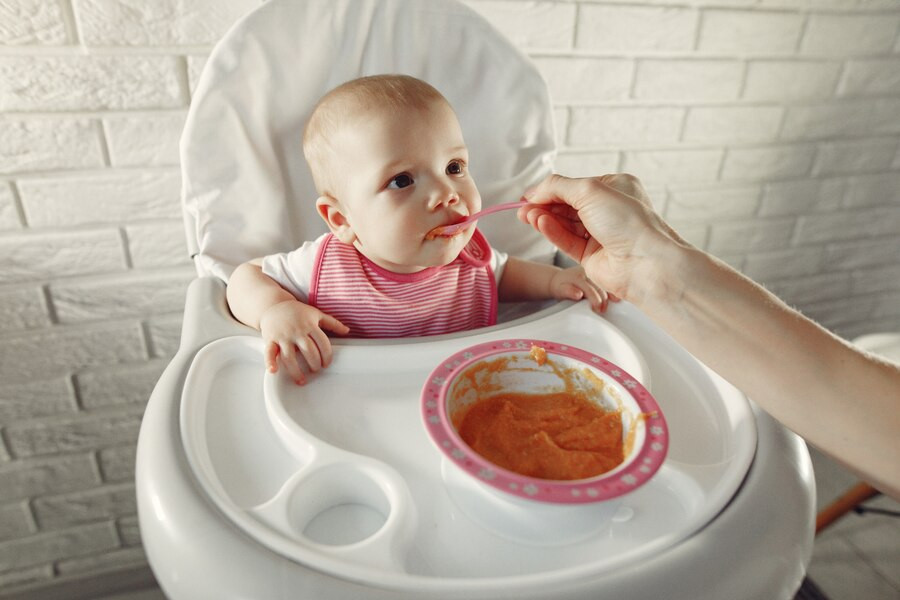One of the biggest challenges for parents is when their baby starts to eat what is known as complementary foods, or first solid food. Certain babies may have digestive issues, be picky eaters, avoid food, or even have food allergies.
Learn what problems are most common when babies begin to eat complementary foods so that you may plan accordingly. Also, understand how to overcome it.
The Challenges of Introducing Complementary Foods to Your Baby
Babies put out their tongues when feeding
It is an extrusion response in which the newborn sticks out his tongue when offered solid food. This reflex is a natural mechanism that babies use to avoid choking by pushing strange items out of their mouths.
If the baby experiences this reflex, mix solid food with breast milk, formula milk, or water to make it more liquid and easier to swallow. This can help make the food taste more familiar, so the infant feels more comfortable consuming it.
It is recommended to introduce food in small quantities using a small spoon or fingertip, allowing the baby to gradually adapt.
Read more: The Idea Of MPASI Rich In Iron Content
The babies vomit food
Babies vomit for a number of reasons, including rejecting the food, discomfort, or being full. Babies who are full typically display signals of fullness by closing their lips, tilting their heads, or pushing food out. End the feeding session immediately and allow the baby to relax.
However, if he has only just begun eating and is already vomiting, try a different meal variation or adjust the consistency. If your infant continues to vomit out food after multiple efforts, do not force him to eat. Forced feeding can result in poor eating experiences for a newborn, which can have long-term consequences.
Babies constantly turn their heads
Babies have unique ways of communicating with their parents. Turning away or denying the spoon could be a possible response.
An infant who is either full or fatigued will reject food. If you think your baby hasn't eaten enough and he appears tired, try feeding him after a nap or when he's awake. Find out whether the baby is not feeling well, is teething, is distracted by the sound of the TV, or has other distractions.
To help your babies learn the difference between fullness and hunger, don't push them to eat; instead, accept their requests
Read more: How Much Should MPSI Portion For Babies?
Some foods cause babies to break out in rashes
Babies may experience food allergies if you detect a rash on their bottoms or around their mouths after they eat particular foods, such eggs or seafood. Keep an eye out for further allergy symptoms such swelling, shortness of breath, or vomiting. If the baby develops signs of a severe allergic response, such as difficulty breathing or swallowing, take him to the hospital immediately.
Babies refuse to feed on their own
It is common for a baby to refuse to eat on their own. MPASI or complementary foods, is part of the learning process, which takes time and patience. Give him a spoon with a short handle to make it simpler for his little hands, which are still learning to hold. Serve foods that are brightly colored and chopped by length, making them easy to pick up and eat.
Starting MPASI or complementary foods is usually difficult, and you must be patient to overcome every challenge. If you have problems feeding your child and the child consistently refuses his first meal, you can either visit a doctor or make use of the consultation features that are available in the Ai Care application by downloading the Ai Care application from the App Store or Play Store.
Looking for more information about pregnancy, breastfeeding, and the health of women and children? Click here!
- dr Nadia Opmalina
Maria Masters (2021). Common Baby Feeding Problems After You Introduce Solids. Available from: https://www.whattoexpect.com/first-year/baby-feeding/baby-feeding-problems-introducing-solids
Raising Children (2023). Introducing solids: why, when, what and how. Available from: https://raisingchildren.net.au/babies/breastfeeding-bottle-feeding-solids/solids-drinks/introducing-solids
Kids Health (2021). When Can My Baby Start Eating Solid Foods?. Available from: https://kidshealth.org/en/parents/solid-foods.html
Healthy Children (2022). Starting Solid Foods. Available from: https://www.healthychildren.org/English/ages-stages/baby/feeding-nutrition/Pages/Starting-Solid-Foods.aspx
Ashley Marcin (2018). What Is Extrusion Reflex?. Available from: https://www.healthline.com/health/parenting/extrusion-reflex
Kids Health (2021). Feeding Your Newborn. Available from: https://kidshealth.org/en/parents/feednewborn.html
Gina Shaw (2023). Feeding Baby: How to Avoid Food Allergies. Available from: https://www.webmd.com/parenting/baby/introducing-new-foods











